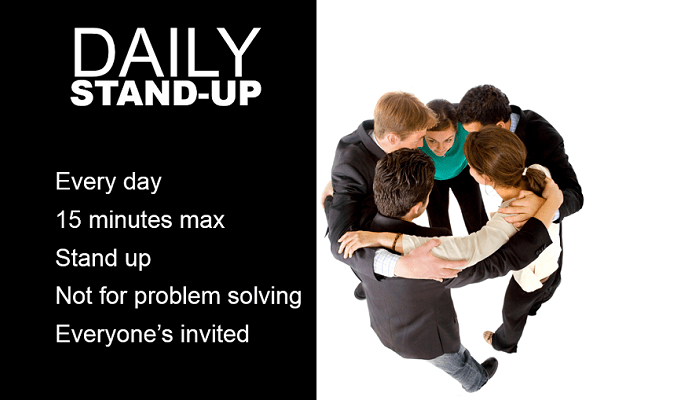
Goodbye boring meetings, hello Agile – Implementing the daily stand-up
How many times have you sat down for a company meeting and most of everyone is fiddling with something? Their phone, scribbling on a paper, taking that zillionth sip on a cup of coffee or just about any distraction while the meeting is going on.
Or, you can go to meetings where cell phones, laptops, pads of papers, etc are banned, and eyes are on the clock, bored and waiting for the meeting to be over.
So how do you keep everyone engaged in the meeting, but without distractions? Enter Agile management.
What is Agile?
If you are like me (i.e. not a developer or product manager), you’ve probably heard of terms like agile management and scrum in relation to software and product development, but have no idea what they are. Arriving at my new firm, Cappitech, where agile management guides their financial technology process, I have gotten a crash course in just a few days about its benefits and how it can be applied to all areas of business.
So what is Agile management and do I need to be a computer go to understand it?
The short answer is that agile is a management process for handling the creation of new ideas and bringing them to reality, and isn’t exclusive to the technology world. The foundation of the process is one of being very team oriented and focused on short term tasks as part of reaching a larger long term product goal. As a result, when people explain agile, you’ll hear terms like ‘empowering the entire team’, ‘daily feedback’ and ‘working quickly’.
Working together, agile teams map out the larger product goal with small steps that can be achieved in two week or less time-frames.. The process is then followed up with short daily meetings among members of team.
Stand-up meetings
Often called stand-up meetings, as the name describes, agile team members stand during the meeting. By doing such, it keeps everyone’s eyes away from their computers and desk. But, since no one wants to stand for too long, updates are kept short and to the point.
The quick updates (usually two minutes or less) focus on what each member has accomplished lately, where they are within their short term goal and any impediments in their work. However, rather than getting to deep in development impediments, problem solving conversations are held separate from the meeting between the specific team members that can help and those with the problem.
The benefit of this approach is that meetings are ‘agile’. Everyone more or less gets a quick idea of what their team members are doing, but it’s not too extensive of an update that the meeting becomes a bore-fest. Afterwards, the deeper detail descriptions of what is taking place and problem solving remains between the relevant parties, thus saving time for team members that these issues are less relevant to.
For an outsider such as myself (I’m the BizDev guy who sits in on the stand-up meeting of Capptivate, our EMIR reporting product for EU regulated brokers) the agile ‘experience’ is perfect. Even though I have little idea of the developer speak taking place at the meeting, the short updates are general enough that I can more or less follow what is going on. Also, as technical details are discussed in smaller groups outside the meeting, I don’t need to be around when they are taking place, which leaves me plenty of times to focus on my work.
Goodbye boring meetings, hello Agile!!!




